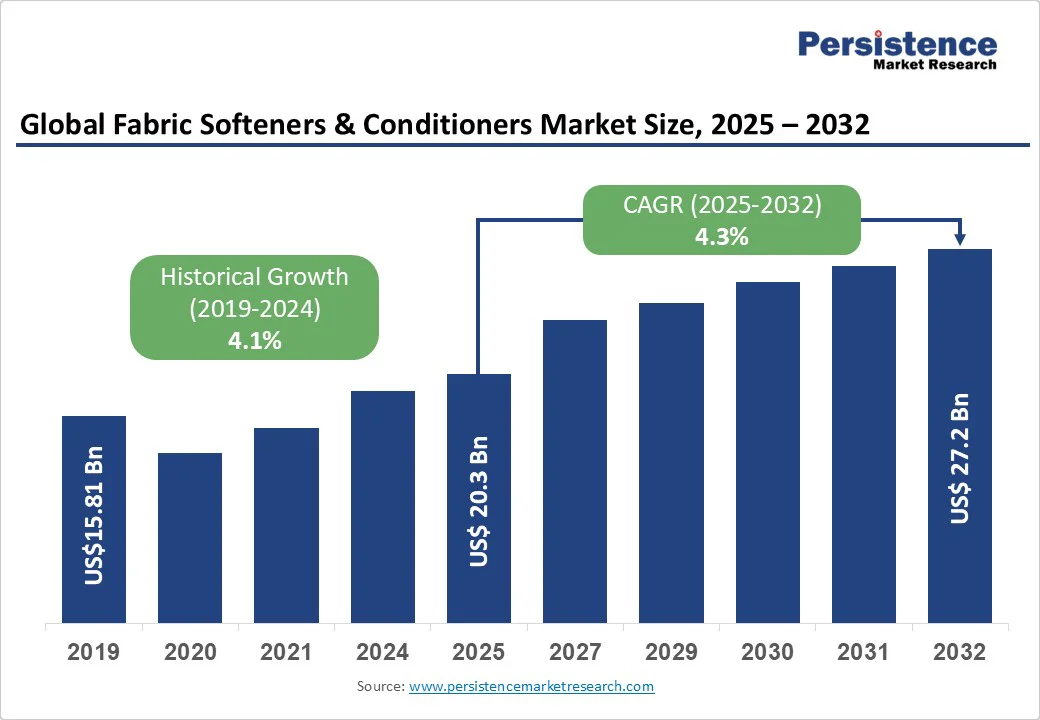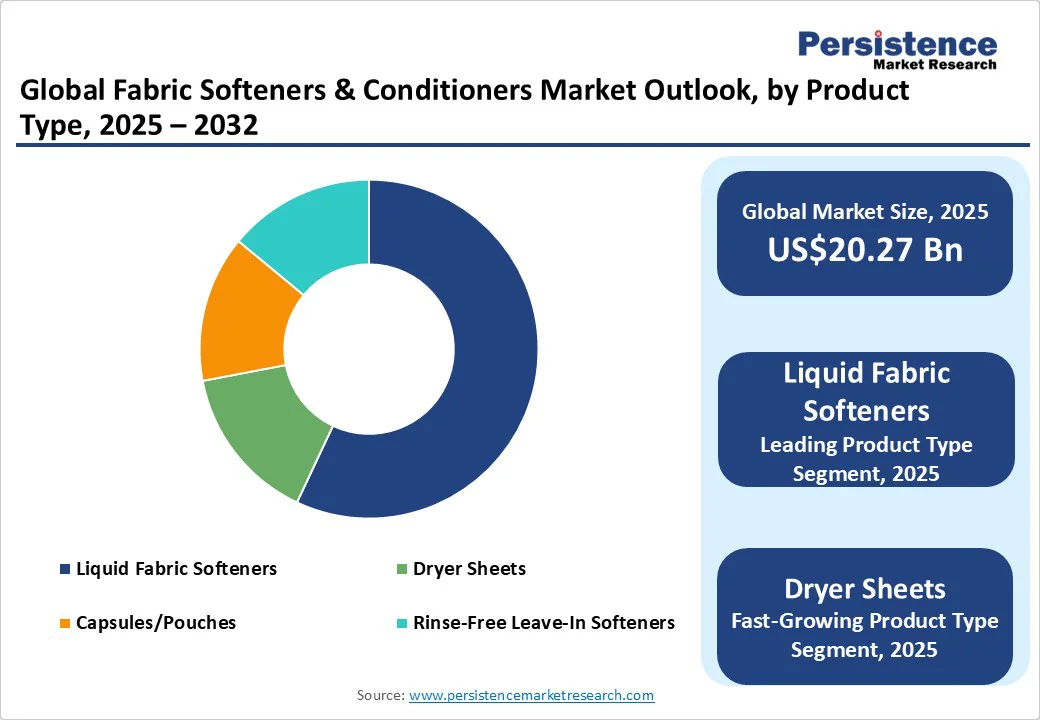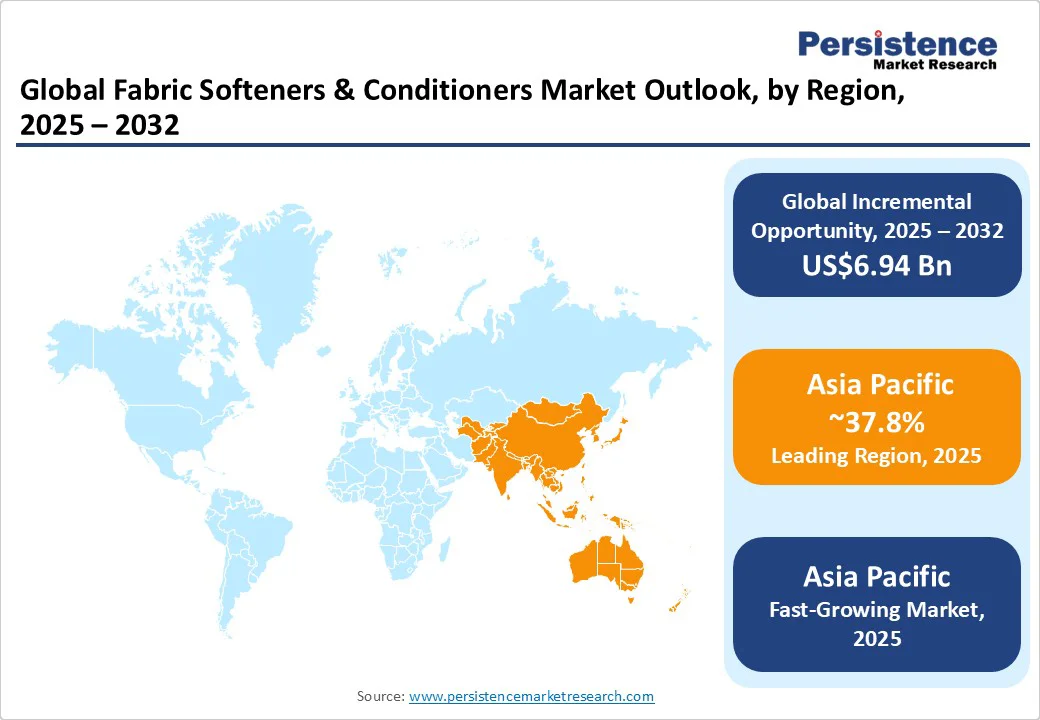ID: PMRREP34340| 188 Pages | 25 Sep 2025 | Format: PDF, Excel, PPT* | Consumer Goods

The global fabric softeners & conditioners market size is likely to be valued at US$20.27 Bn in 2025 and is expected to reach US$27.21 Bn by 2032, growing at a CAGR of 4.3% during the forecast period from 2025 to 2032, driven by rising consumer focus on garment care, fragrance, and convenience in laundry routines. Growing urbanization, premiumization of household products, and increasing awareness of fabric longevity are encouraging demand across both liquid and sheet-based formats.
| Key Insights | Details |
|---|---|
|
Fabric Softeners & Conditioners Market Size (2025E) |
US$20.27 Bn |
|
Market Value Forecast (2032F) |
US$27.21 Bn |
|
Projected Growth (CAGR 2025 to 2032) |
4.3% |
|
Historical Market Growth (CAGR 2019 to 2024) |
4.1% |

The market growth is propelled by the rising adoption of water-efficient, leave-in fabric softeners that cater to households in water-scarce regions and urban centers with limited access to resources. These products minimize the need for additional rinse cycles, reducing both water and energy consumption while offering enhanced convenience for time-pressed consumers. The shift toward rinse-free laundry solutions aligns with sustainability goals, positioning brands that invest in such innovations to capture eco-conscious segments and strengthen their market competitiveness.
Another key growth factor is the development of concentrated biodegradable softeners and hypoallergenic fabric conditioner solutions designed for consumers with sensitive skin and for specialty fabrics such as silk, wool, sportswear, and infant clothing. These targeted offerings appeal to niche segments focused on performance, safety, and sustainability converge, ensuring higher customer loyalty and premium pricing opportunities. By integrating plant-based, skin-safe fabric care technologies, manufacturers are addressing demand for both environmental responsibility and health-driven product innovation, which is reshaping the competitive landscape of the fabric softeners & conditioners market.
The market faces challenges from the growing adoption of detergent and fabric softener combination products, which reduce the need for standalone conditioners. These multifunctional formats resonate with consumers looking for convenience and space-saving solutions, particularly in urban households. At the same time, the increasing use of wool dryer balls and other scent-free static control alternatives is shifting consumer preferences toward reusable, chemical-free solutions. This shift directly impacts demand for conventional fabric softeners, especially among environmentally conscious consumers who prioritize sustainability and long-term value.
Another restraint emerges from the operational issues associated with fabric softeners in high-efficiency washing machines. Residue buildup can cause unpleasant odors, clogging, and even reduce the appliance’s performance, prompting some consumers to limit or discontinue use. Concerns around absorbency loss in towels and reduced effectiveness of moisture-wicking sportswear also weaken consumer trust in traditional formulations. These functional drawbacks create hesitation among active-lifestyle and performance-oriented buyers, highlighting a structural challenge for manufacturers seeking to expand the long-term relevance of fabric softeners and conditioners.
Innovation in micro-encapsulated fragrance delivery systems is opening new growth avenues for fabric softeners and conditioners. These advanced formulations release scent gradually during the wash and wear cycle, creating a premium sensory experience that extends well beyond laundry day. Products with long-lasting fragrance retention are gaining strong traction among consumers seeking lifestyle enhancement alongside garment care, and brands that invest in this space are well-positioned to capture share in the fast-expanding scent-enhancer segment. The ability to combine functional fabric care with elevated fragrance performance makes this a lucrative opportunity for market leaders.
Personalization is emerging as another major growth driver, with consumers increasingly drawn to custom-scent laundry solutions and AI-enabled fabric care recommendations. Advances in digital platforms now allow customers to choose or even design their preferred fragrance profiles, while AI tools can suggest conditioners tailored to specific fabrics such as activewear, baby clothing, or luxury garments. This level of customization strengthens consumer engagement and supports premium pricing models, allowing brands to differentiate in a crowded market. By aligning with trends in personalization and smart home ecosystems, fabric softener manufacturers can create long-term loyalty and expand revenue potential.
In product type, liquid fabric softeners are leading with a share of approximately 56.7% due to their alignment with consumer habits and expectations for comprehensive laundry care. Their ability to combine softness, fragrance retention, and anti-static benefits in a single solution makes them indispensable in most households.
Liquids are also easy to dose, compatible with both standard and high-efficiency washing machines, and often marketed in concentrated forms that reduce storage and transportation costs. Strong marketing investments from global players such as Unilever’s Comfort and P&G’s Downy have further entrenched this dominance, creating brand loyalty across diverse regions. The variety of liquid formulations, ranging from premium scent boosters to hypoallergenic lines, ensures broad appeal across consumer segments.
Dryer sheets are the fastest-growing, due to their unmatched convenience and evolving eco-friendly positioning. They require no additional measuring or liquid handling, appealing strongly to consumers in developed markets where dryer use is high. Their single-use nature is increasingly being reimagined with biodegradable substrates and allergen-free scents, helping them overcome environmental concerns while appealing to sustainability-minded buyers.
Conventional petrochemical-based fabric softeners lead with 58% share due to their affordability and established trust. These products have been on the market for decades and consistently deliver results at affordable prices, making them the default choice for mass-market consumers.
Their long distribution history in supermarkets and hypermarkets ensures availability across urban and rural regions, while legacy brands continuously reinforce consumer familiarity through advertising and promotions. Even as eco-conscious alternatives gain traction, conventional formulations remain the most reliable and cost-efficient choice for households in price-sensitive regions, sustaining their large market share.
The fastest-growing formulation segment, plant-based and biodegradable softeners, is expanding rapidly as consumers increasingly prioritize health and environmental safety. These products address growing concerns about chemical residues, skin sensitivities, and the ecological footprint of traditional softeners. The shift is reinforced by regulatory momentum and retailer support as major chains allocate more shelf space to green-certified products.
Plant-based softeners also resonate with premium and millennial consumers who are willing to pay more for sustainable, skin-safe options. Brands such as Seventh Generation and Method utilize clear eco-labeling and recyclable packaging to capitalize on this demand.

North America represents one of the most mature markets for fabric softeners and conditioners, characterized by strong consumer awareness and a long history of brand loyalty. The region is shaped by product innovations that focus on convenience and premium scent experiences. Liquid softeners remain dominant, but dryer sheets play a particularly important role here, given the high penetration of tumble dryers in U.S. households.
In recent years, brands such as Procter & Gamble’s Downy have introduced long-lasting fragrance capsules and anti-wrinkle solutions, tapping into the demand for multifunctional laundry care. Similarly, Bounce has maintained its leadership in dryer sheets by developing eco-friendly versions that address growing sustainability concerns.
Asia Pacific is the fastest-growing and leading regional market, with over 37.8% of market share, driven by rapid urbanization, rising disposable incomes, and increasing washing machine penetration. China and India are the dominant contributors, but markets such as Japan, South Korea, and Indonesia are also expanding quickly as consumers shift toward modern laundry habits.
In China, premium and fragrance-focused products are in high demand, especially among middle-income households aiming to enhance their home care routines. E-commerce platforms such as Tmall and JD.com have accelerated access to international brands such as Downy and Comfort, as well as domestic eco-friendly newcomers.
In India, fabric softeners are transitioning from luxury items to everyday essentials, particularly in urban centers. Hindustan Unilever’s Comfort has seen strong uptake by linking fabric care with aspirational marketing campaigns, positioning conditioners as a way to ‘elevate everyday laundry.’ Similarly, Godrej’s Ezee continues to expand by targeting delicate fabrics and winter wear, reflecting localized consumer needs.
In Japan and South Korea, consumers are increasingly selective about sensory experiences and product aesthetics. Japanese consumers value subtle fragrances and minimalist packaging, leading to innovations such as fragrance-free or low-scent softeners designed to complement cultural preferences. South Korea, with its tech-savvy population, has seen the rise of smart laundry solutions where fabric conditioners are being integrated with AI-enabled washing machines, offering automated dosing and optimized care settings.
Europe stands out as the most sustainability-driven region for fabric softeners and conditioners. Consumers here actively seek products that minimize environmental impact without compromising on performance. This has fueled the popularity of concentrated liquid formulations, which reduce both water usage and packaging waste.
Germany, a key market in the region, has witnessed growing adoption of Ecover and other eco-certified products that prioritize biodegradability. At the same time, local players are innovating with refill stations in supermarkets, particularly in urban centers, including Berlin and Hamburg, reflecting a broader cultural emphasis on circular economy practices.
U.K. is a significant market, where concentrated conditioners dominate household preferences. Consumers are increasingly drawn to hypoallergenic and dermatologically tested formulations, particularly for baby care and sensitive skin. Brands such as Comfort Pure have carved out a strong presence by marketing themselves as family-friendly and skin-safe solutions.

The global fabric softeners & conditioners market is highly competitive, dominated by a mix of multinational giants and regional players who leverage brand recognition, product innovation, and extensive distribution networks. Companies such as Procter & Gamble (Downy, Bounce), Unilever (Comfort, Persil), and Henkel (Snuggle) account for a significant share through strong retail presence and continuous product development, including concentrated formulas, micro-encapsulated fragrances, and hypoallergenic lines. These leaders invest heavily in marketing and R&D to maintain loyalty and stay ahead of emerging consumer trends.
Regional and niche brands are gaining traction by focusing on eco-friendly, plant-based, and specialty formulations that appeal to environmentally conscious and health-sensitive consumers. Brands such as Seventh Generation, Method, and Ecover are expanding in North America and Europe, while local innovators such as Godrej Ezee in India cater to culturally specific needs and emerging middle-class demand.
The fabric softeners & conditioners market size is estimated at US$20.27 Bn in 2025.
The fabric softeners & conditioners market is projected to reach US$27.21 Bn by 2032.
Key trends include growing demand for eco-friendly and biodegradable formulations and rising popularity of concentrated liquids and dryer sheets.
Liquid fabric softeners are the largest product type, accounting for approximately 56.7% of the market share, due to their convenience, fragrance longevity, and compatibility with modern washing machines.
The fabric softeners & conditioners market is expected to grow at a CAGR of 4.3% from 2025 to 2032.
The key players include Procter & Gamble (Downy, Bounce), Unilever (Comfort, Persil), Henkel (Snuggle, Persil), Seventh Generation, and Ecover.
| Report Attribute | Details |
|---|---|
|
Historical Data/Actuals |
2019 - 2024 |
|
Forecast Period |
2025 - 2032 |
|
Market Analysis |
Value: US$ Bn |
|
Geographical Coverage |
|
|
Segmental Coverage |
|
|
Competitive Analysis |
|
|
Report Highlights |
|
By Product Type
By Formulation
By Application
By Distribution Channel
By Region
Delivery Timelines
For more information on this report and its delivery timelines please get in touch with our sales team.
About Author